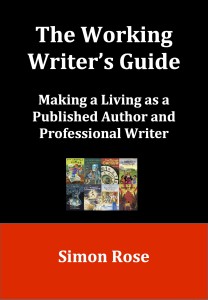What’s it all about? An excerpt from The Working Writer’s Guide
“A great resource for beginning and established writers.”
Introduction
Misconceptions are common regarding published authors. People think either that all authors earn millions or that it’s impossible to make a living as a writer. While some writers are financially successful with their e-books, success stories are rare, at least for now, and only a handful of authors make serious money from e-books.
Misconceptions also abound regarding authors who write for children. Books for younger readers are often mistakenly considered to be simple to write and easy to make money from. Some people look at the phenomenal success of the Harry Potter series and wonder how hard it can really be. After all, anyone can write a book, can’t they?
This book examines the working life of those who have chosen to pursue writing as a career and have no other source of income. In reality, most full-time children’s writers have multiple sources of income. Authors do earn money from royalties from their book sales, but in most cases this isn’t enough to live on. It’s certainly possible to make a living based on you r writing, but a number of different revenue streams are required. Some of these may be more important than others at one time or another, depending on a variety of factors.
r writing, but a number of different revenue streams are required. Some of these may be more important than others at one time or another, depending on a variety of factors.
Working as an instructor at universities and colleges may only be possible for those writers living in large cities and towns. Working for magazines or nonfiction publishers may also be easier if you’re in an urban area, although with the right connections this may not be an obstacle. If you write for websites or social media outlets, or create brochures and similar material for local companies, opportunities will be more plentiful in a larger market. School visits too are obviously easier to secure for writers located in parts of the country with large populations and more schools. However, more competition will also exist with other authors that are contacting those schools trying to book visits, readings, and workshops. Some children’s authors and illustrators will get the majority of their income from school visits, others from advances and royalties from book sales, but everyone’s situation is different. The pattern of a writer’s earnings will also vary from year to year, with one or another source of income being larger or smaller each time.
I was aware at the outset that it might be difficult to make a living from royalties alone. I therefore knew I’d need to explore other ways to earn an income. I need to be engaged in a variety of different projects in order to make a living, but fortunately, most of these are related to writing for children. In addition to my novels for middle-grade readers, I’ve written many non-fiction books and magazine articles, and I also create content for the corporate market and for social media. I conduct workshops and residencies at schools, visit summer camps, teach classes for adults at local colleges and universities, and offer coaching, tutoring, and editing services. None of these projects would be possible if I hadn’t written and published books in the first place. Admittedly, this may appear to be a diverse portfolio and one that doesn’t allow me to focus exclusively on creating works of fiction. Yet until that elusive movie deal arrives or international bestseller status kicks in, this is the reality for many children’s authors. If someone is fully committed to making a career as a full-time, professional children’s writer, he or she has to widen their horizons.
The Working Writer’s Guide is available as an ebook and as a paperback on Amazon, Kobo, Barnes and Noble, iBooks, Smashwords and many other locations.



